[English] 日本語
 Yorodumi
Yorodumi- PDB-8i41: Cryo-EM structure of nanodisc (asolectin) reconstituted GLIC at pH 7.5 -
+ Open data
Open data
- Basic information
Basic information
| Entry | Database: PDB / ID: 8i41 | ||||||
|---|---|---|---|---|---|---|---|
| Title | Cryo-EM structure of nanodisc (asolectin) reconstituted GLIC at pH 7.5 | ||||||
 Components Components | Proton-gated ion channel | ||||||
 Keywords Keywords |  MEMBRANE PROTEIN / pentameric ligand-gated ion channels / cis-loop / MEMBRANE PROTEIN / pentameric ligand-gated ion channels / cis-loop /  cryo-EM / cryo-EM /  nanodisc nanodisc | ||||||
| Function / homology |  Function and homology information Function and homology information sodium channel activity / extracellular ligand-gated monoatomic ion channel activity / sodium channel activity / extracellular ligand-gated monoatomic ion channel activity /  potassium channel activity / transmembrane signaling receptor activity / identical protein binding / potassium channel activity / transmembrane signaling receptor activity / identical protein binding /  plasma membrane plasma membraneSimilarity search - Function | ||||||
| Biological species |   Gloeobacter violaceus (bacteria) Gloeobacter violaceus (bacteria) | ||||||
| Method |  ELECTRON MICROSCOPY / ELECTRON MICROSCOPY /  single particle reconstruction / single particle reconstruction /  cryo EM / Resolution: 3.42 Å cryo EM / Resolution: 3.42 Å | ||||||
 Authors Authors | Bharambe, N. / Li, Z. / Basak, S. | ||||||
| Funding support |  Singapore, 1items Singapore, 1items
| ||||||
 Citation Citation |  Journal: Nat Commun / Year: 2024 Journal: Nat Commun / Year: 2024Title: Cryo-EM structures of prokaryotic ligand-gated ion channel GLIC provide insights into gating in a lipid environment. Authors: Nikhil Bharambe / Zhuowen Li / David Seiferth / Asha Manikkoth Balakrishna / Philip C Biggin / Sandip Basak /   Abstract: GLIC, a proton-activated prokaryotic ligand-gated ion channel, served as a model system for understanding the eukaryotic counterparts due to their structural and functional similarities. Despite ...GLIC, a proton-activated prokaryotic ligand-gated ion channel, served as a model system for understanding the eukaryotic counterparts due to their structural and functional similarities. Despite extensive studies conducted on GLIC, the molecular mechanism of channel gating in the lipid environment requires further investigation. Here, we present the cryo-EM structures of nanodisc-reconstituted GLIC at neutral and acidic pH in the resolution range of 2.6 - 3.4 Å. In our apo state at pH 7.5, the extracellular domain (ECD) displays conformational variations compared to the existing apo structures. At pH 4.0, three distinct conformational states (C1, C2 and O states) are identified. The protonated structures exhibit a compacted and counter-clockwise rotated ECD compared with our apo state. A gradual widening of the pore in the TMD is observed upon reducing the pH, with the widest pore in O state, accompanied by several layers of water pentagons. The pore radius and molecular dynamics (MD) simulations suggest that the O state represents an open conductive state. We also observe state-dependent interactions between several lipids and proteins that may be involved in the regulation of channel gating. Our results provide comprehensive insights into the importance of lipids impact on gating. | ||||||
| History |
|
- Structure visualization
Structure visualization
| Structure viewer | Molecule:  Molmil Molmil Jmol/JSmol Jmol/JSmol |
|---|
- Downloads & links
Downloads & links
- Download
Download
| PDBx/mmCIF format |  8i41.cif.gz 8i41.cif.gz | 333.5 KB | Display |  PDBx/mmCIF format PDBx/mmCIF format |
|---|---|---|---|---|
| PDB format |  pdb8i41.ent.gz pdb8i41.ent.gz | 276.3 KB | Display |  PDB format PDB format |
| PDBx/mmJSON format |  8i41.json.gz 8i41.json.gz | Tree view |  PDBx/mmJSON format PDBx/mmJSON format | |
| Others |  Other downloads Other downloads |
-Validation report
| Arichive directory |  https://data.pdbj.org/pub/pdb/validation_reports/i4/8i41 https://data.pdbj.org/pub/pdb/validation_reports/i4/8i41 ftp://data.pdbj.org/pub/pdb/validation_reports/i4/8i41 ftp://data.pdbj.org/pub/pdb/validation_reports/i4/8i41 | HTTPS FTP |
|---|
-Related structure data
| Related structure data |  35161MC 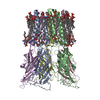 8i42C 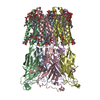 8i47C 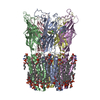 8i48C 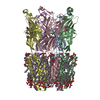 8jj3C 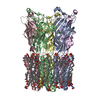 8wcqC 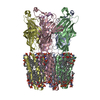 8wcrC M: map data used to model this data C: citing same article ( |
|---|---|
| Similar structure data | Similarity search - Function & homology  F&H Search F&H Search |
- Links
Links
- Assembly
Assembly
| Deposited unit | 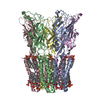
|
|---|---|
| 1 |
|
- Components
Components
| #1: Protein | Mass: 35846.266 Da / Num. of mol.: 5 Source method: isolated from a genetically manipulated source Source: (gene. exp.)   Gloeobacter violaceus (bacteria) / Gene: glvI, glr4197 / Production host: Gloeobacter violaceus (bacteria) / Gene: glvI, glr4197 / Production host:   Escherichia coli (E. coli) / References: UniProt: Q7NDN8 Escherichia coli (E. coli) / References: UniProt: Q7NDN8#2: Chemical | ChemComp-PLC / Has ligand of interest | Y | |
|---|
-Experimental details
-Experiment
| Experiment | Method:  ELECTRON MICROSCOPY ELECTRON MICROSCOPY |
|---|---|
| EM experiment | Aggregation state: PARTICLE / 3D reconstruction method:  single particle reconstruction single particle reconstruction |
- Sample preparation
Sample preparation
| Component | Name: pentameric ligand-gated ion channel / Type: COMPLEX / Entity ID: #1 / Source: RECOMBINANT | |||||||||||||||
|---|---|---|---|---|---|---|---|---|---|---|---|---|---|---|---|---|
| Source (natural) | Organism:   Gloeobacter violaceus (bacteria) Gloeobacter violaceus (bacteria) | |||||||||||||||
| Source (recombinant) | Organism:   Escherichia coli (E. coli) Escherichia coli (E. coli) | |||||||||||||||
| Buffer solution | pH: 7.5 | |||||||||||||||
| Buffer component |
| |||||||||||||||
| Specimen | Conc.: 1.4 mg/ml / Embedding applied: NO / Shadowing applied: NO / Staining applied : NO / Vitrification applied : NO / Vitrification applied : YES : YES | |||||||||||||||
| Specimen support | Grid material: GOLD / Grid mesh size: 300 divisions/in. / Grid type: Quantifoil R1.2/1.3 | |||||||||||||||
Vitrification | Instrument: FEI VITROBOT MARK IV / Cryogen name: ETHANE / Humidity: 100 % |
- Electron microscopy imaging
Electron microscopy imaging
| Experimental equipment |  Model: Titan Krios / Image courtesy: FEI Company |
|---|---|
| Microscopy | Model: FEI TITAN KRIOS |
| Electron gun | Electron source : :  FIELD EMISSION GUN / Accelerating voltage: 300 kV / Illumination mode: FLOOD BEAM FIELD EMISSION GUN / Accelerating voltage: 300 kV / Illumination mode: FLOOD BEAM |
| Electron lens | Mode: BRIGHT FIELD Bright-field microscopy / Nominal defocus max: 2000 nm / Nominal defocus min: 1000 nm / Cs Bright-field microscopy / Nominal defocus max: 2000 nm / Nominal defocus min: 1000 nm / Cs : 2.7 mm : 2.7 mm |
| Specimen holder | Cryogen: NITROGEN / Specimen holder model: FEI TITAN KRIOS AUTOGRID HOLDER |
| Image recording | Electron dose: 40 e/Å2 / Detector mode: SUPER-RESOLUTION / Film or detector model: GATAN K2 SUMMIT (4k x 4k) |
- Processing
Processing
| EM software |
| ||||||||||||||||||||||||||||||||||||||||
|---|---|---|---|---|---|---|---|---|---|---|---|---|---|---|---|---|---|---|---|---|---|---|---|---|---|---|---|---|---|---|---|---|---|---|---|---|---|---|---|---|---|
CTF correction | Type: PHASE FLIPPING AND AMPLITUDE CORRECTION | ||||||||||||||||||||||||||||||||||||||||
| Particle selection | Num. of particles selected: 635408 | ||||||||||||||||||||||||||||||||||||||||
| Symmetry | Point symmetry : C5 (5 fold cyclic : C5 (5 fold cyclic ) ) | ||||||||||||||||||||||||||||||||||||||||
3D reconstruction | Resolution: 3.42 Å / Resolution method: FSC 0.143 CUT-OFF / Num. of particles: 69953 / Num. of class averages: 1 / Symmetry type: POINT | ||||||||||||||||||||||||||||||||||||||||
| Refine LS restraints |
|
 Movie
Movie Controller
Controller








 PDBj
PDBj





